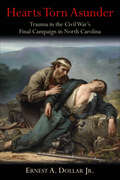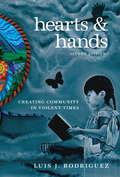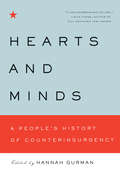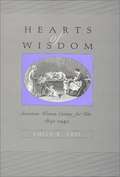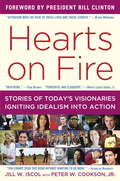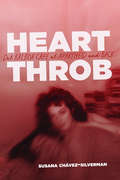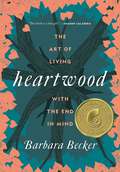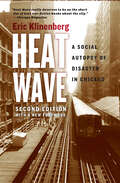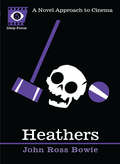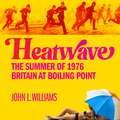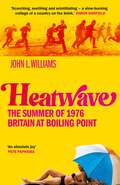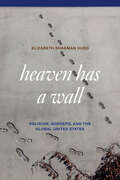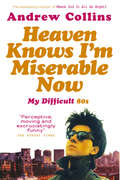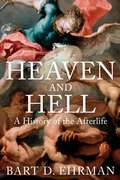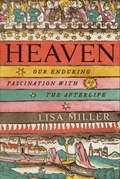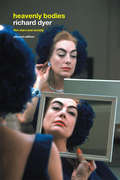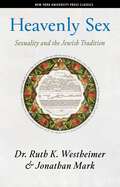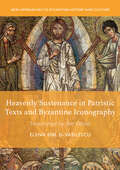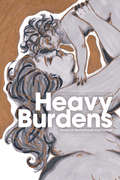- Table View
- List View
Hearts Torn Asunder: Trauma in the Civil War’s Final Campaign in North Carolina
by Ernest A. Dollar&“This study goes beyond the military aspects to examine the psychological and emotional impacts on the participants, both military and civilian.&” —Charles R. Knight, author of From Arlington to Appomattox One day after General Robert E. Lee&’s surrender on April 9, 1865, more than 120,000 Union and Confederate soldiers were still in the field bringing war with them as they moved across North Carolina&’s verdant heartland. Thousands of paroled Rebels, desperate, distraught, and destitute, added to the chaos by streaming into the state from Virginia. Grief-stricken civilians, struggling to survive in a collapsing world, were caught in the middle. The collision of these groups formed a perfect storm long ignored by those wielding pens. Hearts Torn Asunder explores the psychological experience of these soldiers and civilians during the chaotic closing weeks of the war. Their letters, diaries, and accounts reveal just how deeply the killing, suffering, and loss had hurt and impacted these people by the spring of 1865. Dollar deftly recounts the experiences of men, women, and children who endured intense emotional, physical, and moral stress during the war&’s dramatic climax. Their emotional, irrational, and often uncontrollable reactions mirror symptoms associated with trauma victims today, all of which combined to shape memory of the war&’s end. Once the armies left North Carolina after the surrender, their stories faded with each passing year. Neither side looked back and believed there was much that was honorable to celebrate. Hearts Torn Asunder recounts at a very personal level what happened during those closing days that made a memory so painful that few wanted to celebrate, but none could forget.
Hearts and Hands, Second Edition
by Luis J. RodriguezHearts and Hands focuses on healing through community building. Empowered by thirty years of experience with gangs in Los Angeles and Chicago, Rodri guez offers a unique book of change. He makes concrete suggestions, shows how we can create nonviolent opportunities for youth today, and redirects kids into productive and satisfying lives. And he warns that we sacrifice community values for material gain when we incarcerate or marginalize people already on the edge of society. His drive to dissolve gang influence on kids is as personal as it is societal; his son, to whom he dedicates Hearts and Hands, served more than a decade in prison for gang-related activity. With anecdotes, interviews, and time-tested guidelines, Hearts and Hands makes a powerful argument for building and supporting community life. From the Trade Paperback edition.
Hearts and Hands: Creating Community in Violent Times
by Luis RodriguezHearts and Hands deals with many of the difficult issues addressed in Luis Rodríguez's memoir of gang life, Always Running, but with a focus on healing through community building. Empowered by his experiences as a peacemaker with gangs in Los Angeles and Chicago, Rodríguez offers a unique book of change. He makes concrete suggestions, shows how we can create nonviolent opportunities for youth today, and redirects kids into productive and satisfying lives. And he warns that we sacrifice community values for material gain when we incarcerate or marginalize people already on the edge of society. His interest in dissolving gang influence on black and latino kids is personal as well as societal; his son, to whom he dedicates Hearts and Hands, is currently serving a prison sentence for gang-related activity. With anecdotes, interviews, and time-tested guidelines, Hearts and Hands makes a powerful argument for building and supporting community life.
Hearts and Minds
by Hannah GurmanThe first book of its kind, Hearts and Minds is a scathing response to the grand narrative of U.S. counterinsurgency, in which warfare is defined not by military might alone but by winning the "hearts and minds" of civilians. Dormant as a tactic since the days of the Vietnam War, in 2006 the U.S. Army drafted a new field manual heralding the resurrection of counterinsurgency as a primary military engagement strategy; counterinsurgency campaigns followed in Iraq and Afghanistan, despite the fact that counterinsurgency had utterly failed to account for the actual lived experiences of the people whose hearts and minds America had sought to win.Drawing on leading thinkers in the field and using key examples from Malaya, the Philippines, Vietnam, El Salvador, Iraq, and Afghanistan, Hearts and Minds brings a long-overdue focus on the many civilians caught up in these conflicts. Both urgent and timely, this important book challenges the idea of a neat divide between insurgents and the populations from which they emerge--and should be required reading for anyone engaged in the most important contemporary debates over U.S. military policy.
Hearts of Fire
by The Voice of the MartyrsStories of persecuted Christian women compiled by the Voice of the Martyrs.
Hearts of Wisdom: American Women Caring for Kin, 1850-1940
by Emily K. AbelDrawing upon a wealth of diaries, letters, and case records from hospitals and social service agencies, the author examines the shifting roles of caregivers between 1850 and 1940. In addition to the diaries and letters of literate white woman, she turns to slave narratives from the antebellum south and records from health-care agencies serving American Indians during the first part of the 20th century. Abel shows that women in the 19th century gained self-esteem and status through their knowledge of home remedies and nursing techniques. The medical profession gained strength with the discovery of microbes and the development of medications to treat specific diseases. During the 20th century professionals discredited women who provided health care at home. One chapter discusses mothers of children with epilepsy or mental retardation, who were pressured to place their children in institutions and to sever emotional ties with them. Another chapter explores the shift from American sign language to oralism in the education of deaf children, and the impact this had upon mothers. Abel concludes by looking briefly at the current trend to return more and more caregiving to the home.
Hearts on Fire: Stories of Today's Visionaries Igniting Idealism into Action
by Bill Clinton Peter W. Cookson Jill IscolINSPIRING STORIES OF FOURTEEN VISIONARIES WHO MADE A DIFFERENCE IN THE WORLD--AND A BOLD CALL TO ACTION TO MOTIVATE THE NEXT GENERATION OF LEADERS There's Amy Lehman, a gutsy single mother who is building a floating health clinic on Lake Tanganyika; Jimmie Briggs, a journalist campaigning to stop violence against girls and women; and Jacob Lief, a young American who founded a school for street children in South Africa. You will discover how Josh Nesbit, Isaac Holeman, and Nadim Mahmud are connecting rural patients to hospitals using cellphone technology, how Susana De Anda is bringing fresh water to the migrant workers in California's San Joaquin Valley, and how Andeisha Farid is establishing, in the face of war, orphanages for Afghanistan's child victims of war and poverty. These are just some of the stories that will inspire you. Visionaries don't wait for others to take action. They step out. They are brave. They walk the walk. And they connect with others in deep and real ways. Jill Iscol's message is that everyone has the talent and compassion to make the world a better place. Hearts on Fire is a call to action for all of us.Praise for Hearts on Fire "Attention must be paid to these lives and these stories. In Jill Iscol's capable hands, their stories offer us hope--just when we need it."--Brian Williams, NBC News "What inspiring stories of people who have made meaningful lives through service and sacrifice--one person at a time. These are our world leaders!"--Richard Gere "Hearts on Fire is one of the most inspiring books I've read."--Tina Brown, editor-in-chief, The Daily Beast and Newsweek "Clear and compelling . . . I know you will be inspired by the visionaries in Hearts on Fire."--President Bill Clinton "A powerful call to action for each of us to marry passion with purpose and act boldly in the quest for a more just and sustainable world."--Cheryl Dorsey, president of Echoing Green "Powerful and eloquent, Hearts on Fire is a passionate and infectious invitation to get involved and help make the world a better place."--Henry Louis Gates Jr., Alphonse Fletcher University Professor at Harvard University "A beautifully appointed treasure box filled with inspiration and possibility. You cannot read this book without wanting to do more."--Jacqueline Novogratz, founder and CEO of Acumen Fund "A desperately needed antidote for those discouraged by the dysfunctional politics that have left so many on our planet vulnerable and voiceless."--Billy Shore, founder and executive director of Share Our Strength "Hearts on Fire reminds us that we need to dream again, inspire again, and act again."--Wes Moore, New York Times bestselling author of The Other Wes Moore "Vivid, down-to-earth, and well-told, Hearts on Fire will comfort and inspire anybody trying to do a little bit to make this world a more connected and compassionate place."--Ethan Nichtern, founder of The InterDependence Project, and author of One City: A Declaration of Interdependence
Heartthrob: Del Balboa Cafe al Apartheid and Back
by Susana Chávez-SilvermanHeartthrob: Del Balboa Cafe al Apartheid and Back
Heartwood: The Art of Living with the End in Mind
by Barbara Becker“We can do extraordinary things when we lead with love,” Barbara Becker reminds us in her debut memoir Heartwood.When her earliest childhood friend is diagnosed with a terminal illness, Becker sets off on a quest to immerse herself in what it means to be mortal. Can we live our lives more fully knowing some day we will die?With a keen eye towards that which makes life worth living, interfaith minister, mom and perpetual seeker Barbara Becker recounts stories where life and death intersect in unexpected ways. She volunteers on a hospice floor, becomes an eager student of the many ways people find meaning at the end of life, and accompanies her parents in their final days. Becker inspires readers to live with the end in mind and proves that turning toward loss rather than away from it is the only true way to live life to its fullest. Just as with the heartwood of a tree—the central core that is no longer alive yet supports the newer growth rings—the dead become an enduring source of strength to the living.With life-affirming prose, Becker helps us see that that grief is not a problem to be solved, but rather a sacred invitation—an opportunity to let go into something even greater…a love that will inform all the days of our lives.
Heat Wave: A Social Autopsy of Disaster in Chicago
by Eric KlinenbergOn Thursday, July 13, 1995, Chicagoans awoke to a blistering day in which the temperature would reach 106 degrees. The heat index, which measures how the temperature actually feels on the body, would hit 126 degrees by the time the day was over. Meteorologists had been warning residents about a two-day heat wave, but these temperatures did not end that soon. When the heat wave broke a week later, city streets had buckled; the records for electrical use were shattered; and power grids had failed, leaving residents without electricity for up to two days. And by July 20, over seven hundred people had perished-more than twice the number that died in the Chicago Fire of 1871, twenty times the number of those struck by Hurricane Andrew in 1992--in the great Chicago heat wave, one of the deadliest in American history. Heat waves in the United States kill more people during a typical year than all other natural disasters combined. Until now, no one could explain either the overwhelming number or the heartbreaking manner of the deaths resulting from the 1995 Chicago heat wave. Meteorologists and medical scientists have been unable to account for the scale of the trauma, and political officials have puzzled over the sources of the city's vulnerability. In Heat Wave, Eric Klinenberg takes us inside the anatomy of the metropolis to conduct what he calls a "social autopsy," examining the social, political, and institutional organs of the city that made this urban disaster so much worse than it ought to have been. Starting with the question of why so many people died at home alone, Klinenberg investigates why some neighborhoods experienced greater mortality than others, how the city government responded to the crisis, and how journalists, scientists, and public officials reported on and explained these events. Through a combination of years of fieldwork, extensive interviews, and archival research, Klinenberg uncovers how a number of surprising and unsettling forms of social breakdown--including the literal and social isolation of seniors, the institutional abandonment of poor neighborhoods, and the retrenchment of public assistance programs--contributed to the high fatality rates. The human catastrophe, he argues, cannot simply be blamed on the failures of any particular individuals or organizations. For when hundreds of people die behind locked doors and sealed windows, out of contact with friends, family, community groups, and public agencies, everyone is implicated in their demise. As Klinenberg demonstrates in this incisive and gripping account of the contemporary urban condition, the widening cracks in the social foundations of American cities that the 1995 Chicago heat wave made visible have by no means subsided as the temperatures returned to normal. The forces that affected Chicago so disastrously remain in play in America's cities, and we ignore them at our peril. For the Second Edition Klinenberg has added a new Preface showing how climate change has made extreme weather events in urban centers a major challenge for cities and nations across our planet, one that will require commitment to climate-proofing changes to infrastructure rather than just relief responses.
Heathers: A Novel Approach to Cinema (Deep Focus #5)
by Sean Howe John Ross BowieWhat's your damage?In 1989, Michael Lehmann's black comedy Heathers drew a line in the sand, rebuffing the sweetness and optimism of John Hughes' more popular fare with darkness and death. Launching the careers of Winona Ryder and Christian Slater, Heathers became a cult classic, ranking #5 on Entertainment Weekly's list of the 50 Best High School Movies and inspiring hoards of teen films that vastly overshadow its fame but lack its acid wit, moral complexity, and undeniable emotional punch.For the latest installment of Deep Focus, John Ross Bowie blends captivating memoir with astute analysis, tracing the rebel-teen mythology that links Columbine, heavy metal, and The Catcher in the Rye. With help from Lehmann, screenwriter Daniel Waters, and members of the cast, Bowie thoroughly unpacks the film's peculiar resonance. Brilliant riffs on the etymology of its teen slang, the implications of its title, and its visual debt to Stanley Kubrick show how Heathers-for all its audacious absurdity-speaks volumes about the realities of high school and of life itself.
Heatwave: The Summer of 1976 – Britain at Boiling Point
by John L Williams'Grippingly captures the three months that shook Britain's cultural landscape' PAULINE BLACK'Scorching, seething and scintillating, Heatwave conjures a slow-burning collage of a country on the brink. I lived through those cruel months, and Williams recreates them with intense skill' SIMON GARFIELD'An absolute joy' PETE PAPHIDES'Engrossing...powerful...goes way beyond nostalgia' DAVID KYNASTONWith temperatures soaring to 35ºC, severe water shortages and a sunburned population queuing at the standpipes, the summer of 1976 was always remembered as Britain's hottest.But the wave that hit the UK that year was also cultural and political, with upheaval on the streets, in parliament, on the cricket pitch and on the radios and TV sets of a nation at a crossroads.Before this blistering summer, Britain seemed stuck in the post-war era, a country where people were all in it together - as long as you were white, male and straight. In July, Tom Robinson writes a song called Glad to be Gay, and by August bank holiday, Black youth are making the police run for their lives in the almighty riot at the Notting Hill Carnival. But with the Labour Prime Minister Harold Wilson suddenly quitting, the pound sinking and the economy tanking, a restless immigrant population and increasing dissatisfaction in the old world order, the weather seemed to boil up the country to the point where the lid blows off.Weaving a rich tapestry of the news stories of the year, with social commentary and dozens of first-person interviews with those that were there at the time, Williams's reappraisal of the summer of '76 is an evocative, sometimes nostalgic but always an unflinching read. Heatwave takes us back to relive the events of that summer and asks - have we really moved on as much as we would have liked?
Heatwave: The Summer of 1976 – Britain at Boiling Point
by John L Williams'Grippingly captures the three months that shook Britain's cultural landscape' PAULINE BLACK'Scorching, seething and scintillating, Heatwave conjures a slow-burning collage of a country on the brink. I lived through those cruel months, and Williams recreates them with intense skill' SIMON GARFIELD'An absolute joy' PETE PAPHIDES'Engrossing...powerful...goes way beyond nostalgia' DAVID KYNASTONWith temperatures soaring to 35ºC, severe water shortages and a sunburned population queuing at the standpipes, the summer of 1976 was always remembered as Britain's hottest.But the wave that hit the UK that year was also cultural and political, with upheaval on the streets, in parliament, on the cricket pitch and on the radios and TV sets of a nation at a crossroads.Before this blistering summer, Britain seemed stuck in the post-war era, a country where people were all in it together - as long as you were white, male and straight. In July, Tom Robinson writes a song called Glad to be Gay, and by August bank holiday, Black youth are making the police run for their lives in the almighty riot at the Notting Hill Carnival. But with the Labour Prime Minister Harold Wilson suddenly quitting, the pound sinking and the economy tanking, a restless immigrant population and increasing dissatisfaction in the old world order, the weather seemed to boil up the country to the point where the lid blows off.Weaving a rich tapestry of the news stories of the year, with social commentary and dozens of first-person interviews with those that were there at the time, Williams's reappraisal of the summer of '76 is an evocative, sometimes nostalgic but always an unflinching read. Heatwave takes us back to relive the events of that summer and asks - have we really moved on as much as we would have liked?
Heatwave: The Summer of 1976 – Britain at Boiling Point
by John L Williams'Grippingly captures the three months that shook Britain's cultural landscape' PAULINE BLACK'Scorching, seething and scintillating, Heatwave conjures a slow-burning collage of a country on the brink. I lived through those cruel months, and Williams recreates them with intense skill' SIMON GARFIELD'An absolute joy' PETE PAPHIDES'Engrossing...powerful...goes way beyond nostalgia' DAVID KYNASTONWith temperatures soaring to 35ºC, severe water shortages and a sunburned population queuing at the standpipes, the summer of 1976 was always remembered as Britain's hottest.But the wave that hit the UK that year was also cultural and political, with upheaval on the streets, in parliament, on the cricket pitch and on the radios and TV sets of a nation at a crossroads.Before this blistering summer, Britain seemed stuck in the post-war era, a country where people were all in it together - as long as you were white, male and straight. In July, Tom Robinson writes a song called Glad to be Gay, and by August bank holiday, Black youth are making the police run for their lives in the almighty riot at the Notting Hill Carnival. But with the Labour Prime Minister Harold Wilson suddenly quitting, the pound sinking and the economy tanking, a restless immigrant population and increasing dissatisfaction in the old world order, the weather seemed to boil up the country to the point where the lid blows off.Weaving a rich tapestry of the news stories of the year, with social commentary and dozens of first-person interviews with those that were there at the time, Williams's reappraisal of the summer of '76 is an evocative, sometimes nostalgic but always an unflinching read. Heatwave takes us back to relive the events of that summer and asks - have we really moved on as much as we would have liked?
Heaven Has a Wall: Religion, Borders, and the Global United States
by Elizabeth Shakman HurdAn urgent exploration of borders as sacred objects in American culture. Our national conversation about the border has taken a religious turn. When televangelists declare, “Heaven has a wall,” activists shout back, “Jesus was a refugee.” For Elizabeth Shakman Hurd, the standoff makes explicit a longstanding truth: borders are religious as well as political objects. In this book, Hurd argues that Americans share a bipartisan border religion, complete with an array of beliefs and practices, including a reverence for national security, a liturgy for immigration, and an eschatological foreign policy. Through an analysis of the many ways the United States creates, enforces, and ignores borders at home and abroad, Hurd offers a bold new perspective on the ties that bind American religion, politics, and public life.
Heaven Knows I'm Miserable Now: My Difficult 80s
by Andrew Collins'Higher education comes at exactly the right time: in the twilight of your teens, you're just starting to coagulate as a human being, to pull away from parental influence and find your own feet. What better than three years in which to explore the inner you, establish a feasible worldview, and maybe get on Blockbusters.'After an idyllic provincial 1970s childhood, the 1980s took Andrew Collins to London, art school and the classic student experience. Crimping his hair, casting aside his socks and sporting fingerless gloves, he became Andy Kollins: purveyor of awful poetry; disciple of moany music, and wannabe political activist. What follows is a universal tale of trainee hedonism, girl trouble, wasted grants and begging letters to parents. A synth-soundtracked rite of passage that's often painfully funny, it traces one teenager's metamorphosis from sheltered suburban innocent to semi-mature metropolitan male through the pretensions and confusions of trying to stand alone for the first time in your own kung fu pumps in a big bad city.
Heaven and Hell: A History of the Afterlife
by Bart D. EhrmanWhere did the ideas of heaven and hell come from? 'An engaging but expert guide.' THE TIMES As strange as it may seem to us now, there was a time when no one thought they would go to heaven or hell after they died. In fact, there is no mention of them in the Old Testament, and Jesus did not believe the souls of the departed were bound for either realm. In this gripping history of the afterlife, Bart Ehrman reveals how the concepts of heaven and hell developed and took hold, and why they endure to this day. He examines the social, cultural and historical roots of competing views held by Greeks, Jews and Christians, and traces how beliefs changed over time. Ultimately, he shows that many of our ideas about heaven and hell emerged long after Jesus&’s time, through the struggle to explain the injustices of the world. *** 'There&’s no one I&’d rather read on what Christians believe, and why they believe it, than Bart Ehrman.' TOM BISSELL, AUTHOR OF APOSTLE 'An impressively readable, clear and wide-ranging study.' SPECTATOR 'This elegant history explores the evolution of the concept of the afterlife in Western thought... presented with engaging clarity.' THE NEW YORKER
Heaven on Earth: A Journey Through Shari'a Law from the Deserts of Ancient Arabia to the Streets of the Modern Muslim World
by Sadakat KadriHeaven on Earth is a vivid, revealing, and essential narrative history of shari'a law--the widely contested and misunderstood code of Islamic justice--and how the application of its concepts has changed over time and, with it, the face of Islam.Some fourteen hundred years after the Prophet Muhammad first articulated God's law--the shari'a--its earthly interpreters are still arguing about what it means. Hard-liners reduce it to amputations, veiling, holy war, and stonings. Others say that it is humanity's only guarantee of a just society. And as colossal acts of terrorism made the word "shari'a" more controversial than ever in the early twentieth century, the legal historian and human rights lawyer Sadakat Kadri realized that many people in the West harbored ideas about Islamic law that were hazy or simply wrong. Heaven on Earth describes his journey, through ancient texts and across modern borders, in search of the facts behind the myths.Kadri brings lucid analysis and enlivening wit to the turbulent story of Islam's foundation and expansion, showing how the Prophet Muhammad's teachings evolved gradually into concepts of justice. Traveling the Muslim world to see the shari'a's principles in action, he encounters a cacophony of legal claims. At the ancient Indian grave of his Sufi ancestor, unruly jinns are exorcised in the name of the shari'a. In Pakistan's madrasas, stern scholars ridicule his talk of human rights and demand explanations for NATO drone attacks in Afghanistan. In Iran, he hears that God is forgiving enough to subsidize sex-change operations--but requires the execution of Muslims who change religion. Yet the stories of compulsion and violence are only part of a picture that also emphasizes compassion and equity. Many of Islam's first judges refused even to rule on cases for fear that a mistake would damn them, and scholars from Delhi to Cairo maintain that governments have no business enforcing faith.The shari'a continues to shape explosive political events and the daily lives of more than a billion Muslims. Heaven on Earth is a brilliantly iconoclastic tour through one of humanity's great collective intellectual achievements--and an essential guide to one of the most disputed but least understood controversies of modern times.
Heaven on Earth: God's Call To Community In The Book Of Revelation
by Michael BattleMuch of the literature on the book of Revelation paints a frightening apocalyptic vision of the end times. Michael Battle offers an alternative look at Revelation in this new work, seeing it instead as a hopeful call to bring heaven on earth. Battle explores the problematic imagery found in Revelation before showing how similar problems play out in our contemporary world. Battle sees Revelation as a guide that shows us that we can live out God's call for heaven on earth by living in community with one another, as exhibited through the writings of Martin Luther King Jr., Desmond Tutu, Rowan Williams, and Ubuntu theology. He writes, "I seek to imagine in my particular Christian context how a view of heaven need not lead to culture wars and further excuses for oppressing others. Heaven, as envisioned by John of Patmos, has much greater purpose."
Heaven: Our Enduring Fascination with the Afterlife
by Lisa Miller“Wonderful…. A smart and accessible take on the ultimate question: What is Heaven? Lisa’s book is a good place to begin to find an answer.” — Jon Meacham, Pulitzer Prize-winning author of American Lion“A rare combination of journalism, memoir, and historical research … this smart yet heartfelt book leads us into the center of one of the greatest conversations of all time. And Lisa Miller is the perfect conversation partner.” — Stephen Prothero, New York Times bestselling author of American Jesus and Religious LiteracyA groundbreaking history of the hereafter, Heaven by Newsweek reporter and religion editor Lisa Miller draws from both history and popular culture to reveal how past and presage visions of heaven have evolved and how they inspire us to both good and evil.
Heavenly Bodies: Film Stars and Society (Bfi Cinema Ser.)
by Richard DyerRichard Dyer's classic study of movie stars and stardom has been updated, with a new introduction by the author discussing the rise of celebrity culture and developments in the study of stars since publication of the first edition in 1986. Dyer's illuminating study is based around case studies of three major stars: Marilyn Monroe, Paul Robeson and Judy Garland. He draws on a wide range of sources, including the films in which each star appeared, to illustrate how each star's persona was constructed, and goes on to examine each within the context of particular issues in fan culture and stardom. Students of film and cultural studies will find this an invaluable part of there course reading.
Heavenly Sex: Sexuality and the Jewish Tradition
by Dr. Ruth Westheimer Jonathan MarkCelebrated sex expert and bestselling author Dr. Ruth Westheimer bridges the gap between sex and religion in this provocative exploration of intimacy in the Jewish faithIn this light-hearted, lively tour of Jewish sexuality, Dr. Ruth K. Westheimer and Jonathan Mark team up to reveal how the Jewish tradition is much more progressive than popular wisdom might lead one to believe.Applying Dr. Ruth’s acclaimed brand of couples therapy to such Biblical relationships as Abraham and Sarah, and Joseph and Potiphar’s wife, the authors enlist Biblical lore to explore such topics as surrogacy, incest, and arranged marriages. They offer a clearer understanding of the intertwining relationships between sexuality and spirituality through incisive investigations of the Song of Songs, Ruth, Proverbs, Psalms, and some of the bawdier tales of the Prophets. One chapter provides a provocative new perspective on the Sabbath as a weekly revival, highlighting not only its spiritual nature, but also its marital and sexual aspects.Focusing specifically on Orthodox forms of Judaism and offering Dr. Ruth's singular interpretations, the book answers such questions as: What night of the week is best for making love? How often should couples have sex? Can traditional Jewish notions of sex and sexuality be reconciled with contemporary beliefs? What roles can and do dreams and fantasy play?In Heavenly Sex, America's favorite sex therapist takes readers on a frank and fascinating journey to the heart of Jewish sexuality as she fits twenty-first century sexual mores into an ancient—and lusty—spiritual tradition.
Heavenly Sustenance in Patristic Texts and Byzantine Iconography: Nourished by the Word (New Approaches to Byzantine History and Culture)
by Elena Ene D-VasilescuThis book examines ideas of spiritual nourishment as maintained chiefly by Patristic theologians –those who lived in Byzantium. It shows how a particular type of Byzantine frescoes and icons illustrated the views of Patristic thinkers on the connections between the heavenly and the earthly worlds. The author explores the occurrence, and geographical distribution, of this new type of iconography that manifested itself in representations concerned with the human body, and argues that these were a reaction to docetist ideas. The volume also investigates the diffusion of saints’ cults and demonstrates that this took place on a North-South axis as their veneration began in Byzantium and gradually reached the northern part of Europe, and eventually the entirety of Christendom.
Heavy Burdens: Stories Of Motherhood And Fatness
by Judy VerseghyHeavy Burdens: Stories of Motherhood and Fatness seeks to address the systemic ways in which the moral panic around “obesity” impacts fat mothers and fat children. Taking a life-course approach, the book begins with analyses of the ways in which fatphobia is enacted on pregnant (or even not-yet-pregnant) women, whose bodies immediately become viewed as objects warranting external control by not only medical professionals, but family members, and even passers-by. The story unfolds as adults recount childhood stories of growing up fat, or growing up in fear of being fat, and how their mothers’ relationships with their own bodies and attempted weight-loss experiences shaped how food, exercise, and body management were approached in their homes in sometimes harmful ways. Finally, the book concludes with stories of women who have since become mothers, examining the ways in which having their own children altered their views on their own bodies and their perceptions of their mothers’ actions, and working to find fat-friendly futures via their own parenting (or grand-parenting) techniques.
Heavy Business: Commercial Burglary and Robbery (Routledge Library Editions: Criminology)
by Dermot WalshOriginally published in 1986. Based on interviews with men in prison, this study takes two groups of convicted criminals: men convicted of robbery, and, for comparison, a sample of men convicted for breaking into commercial premises. It focuses on how victims are chosen, the decision-making processes involved, and the characteristics of those selected and those rejected as unsuitable potential victim material. Also described are the pattern of the crime (time, place, gain), and the ways in which people become involved in it. Allowing several convicted robbers describe in their own way why they did it and what they thought and felt about it, Dermot Walsh presents a disquieting picture, in which robbery appears to be an attractive proposition to several different groups of men, facing quite different circumstances, and for different reasons.
